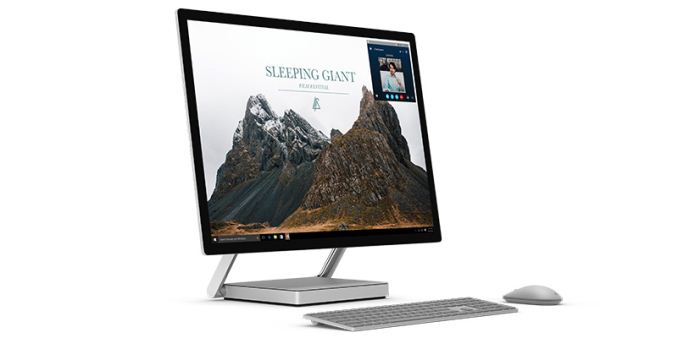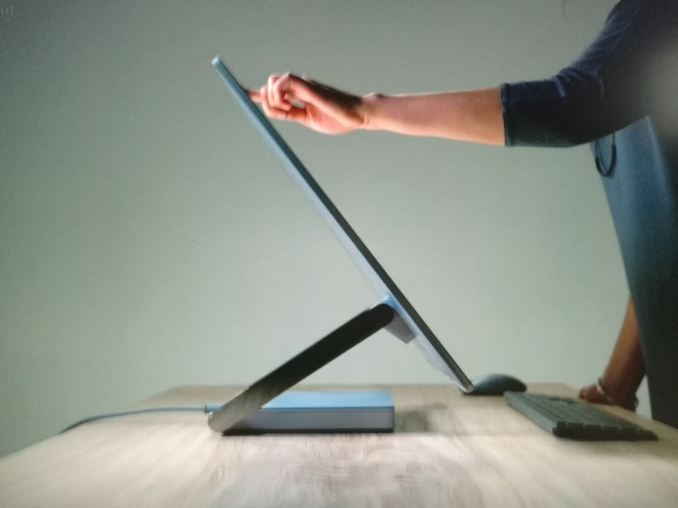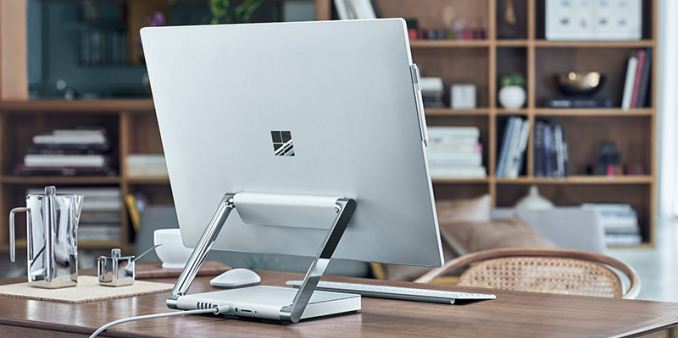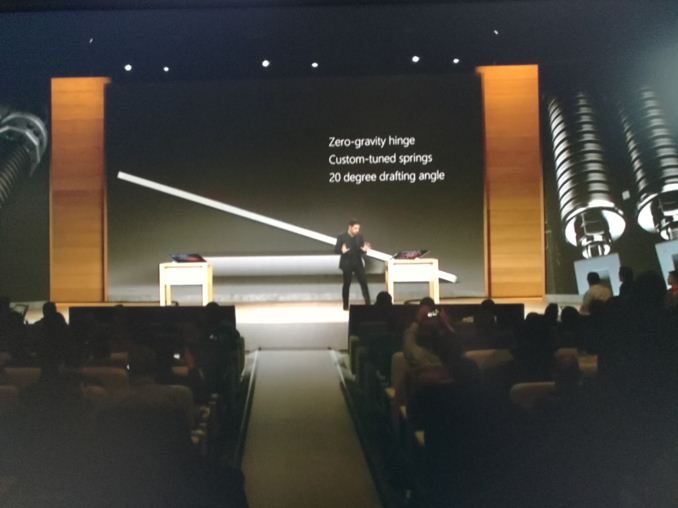Microsoft Announces the Surface Studio: 28-inch AIO with Touch, Pen, 4500x3000, Skylake, GTX 980M
by Ian Cutress on October 26, 2016 12:34 PM EST- Posted in
- Microsoft
- Systems
- Intel
- AIO
- all-in-one
- Surface
- Surface Studio

As part of the now annual Microsoft Surface event, Panos Panay announced the next member of the Surface family, the Surface Studio. The Studio is ultimately a prosumer all-in-one device promising more functionality and versatility than any other desktop all-in-one PC by allowing the device to also turn a desk into a studio.
Front and center in what makes the Studio impressive is the size of the display: a 28-inch thin-bezel LCD display with a 3:2 aspect ratio, coming in at a 4500x3000 resolution and 192 pixels per inch. By contrast to 4K, this is 13.5 million pixels compared to 8.3 million in UHD, and Microsoft is promoting True Scale with the studio such that two A4 pieces of paper can be rendered side by side at full resolution and at a higher DPI than most standard office printers. The display is 12.5mm thin, with Microsoft redesigning the LCD stack to ensure a slim profile.
The display connects to the base via a specialist hinge, featuring 80 machined parts on each side for what Microsoft calls a ‘Zero Gravity Hinge’. This allows the display to be moved seamlessly and for any plausible angle, as well as taking on extra weight in studio mode. The display has two buttons on the right-hand side for power and volume. On the top of the display is the Windows Hello-enabled camera, with a 5.0 MP element capable of 1080p video (we assume 30 FPS). The Studio supports the Surface Pen, which can attach to the side of the display.
For color reproduction, Microsoft is advertising the display as supporting both DCI-P3 and sRGB with a simple toggle on the Windows sidebar to switch between the two. While Microsoft says that the displays are calibrated for both, this has fundamental issues with color reproduction.
In the base is a set of arguably last-generation specifications: 6th generation (Skylake) Intel Core i5 and Core i7 processor options (probably 65W desktop parts?) paired with up to 32GB of DDR4 memory (probably DDR4-2133). This comes with a NVIDIA GTX 965M 2GB for two of the three options, and a GTX 980M 4GB on the high-end model. Connectivity comes via USB 3.0, rather than USB 3.1/Thunderbolt. Storage is labeled as ‘1TB or 2TB Rapid Hybrid Drive’ options, which in the presentation looked like an M.2 drive but as yet it has been unstated if this is SATA or PCIe (or if a Rapid Hybrid Drive actually means an SSHD).
| Microsoft Surface Studio | |||
| CPU | Intel Core i5 Skylake |
Intel Core i7 Skylake |
Intel Core i7 Skylake |
| GPU | NVIDIA GTX 965M 2GB |
NVIDIA GTX 980M 4GB |
|
| DRAM | 8GB DDR4 | 16 GB DDR4 | 32GB DDR4 |
| Storage | 1TB | 1TB | 2TB |
| 'Rapid Storage Drive' (SATA? PCIe? SSHD?) | |||
| Display | 28-inch 4500x3000 LCD Display 12.5mm thin 10-point MultiTouch Magnetic Pen Support |
||
| Connectivity | 802.11ac WiFi (Intel AC 8260?) Gigabit Ethernet Xbox Wireless |
||
| IO | 4 x USB 3.0 Full-Size SD card reader (SDXC) Mini DisplayPort 3.5mm Headset |
||
| Camera | 5MP Front Facing Windows Hello 1080p Recording |
||
| OS | Windows 10 Pro 30-day Office Trial |
||
| Dimensions | Display: 637.35 x 438.90 x 12.50 mm | ||
| Base: 250.00 x 200.00 x 32.2 mm | |||
| Weight: 9.56 kg / 21 lbs | |||
| Price | $2999 | $3499 | $4199 |
Connectivity comes via four USB 3.0 ports, a full-size SD card reader, a mini DisplayPort output and a 3.5mm headset jack. WiFi is provided by an 802.11ac unit, although Microsoft does not say which one (I’d hazard a guess and say Intel’s AC8260 2x2 solution). The unit also supports Xbox Wireless, allowing for Xbox controllers to also be connected for gaming.
The whole unit weighs in at 21 lbs (9.5 kg), and Microsoft has stated that it will be available only in limited quantities during Q4, with the official release date as 15th December. Current configurations available will be:
$2999 : Intel Core i5 (Skylake), 8 GB DDR4, 1TB, GTX 965M 2GB
$3499 : Intel Core i7 (Skylake), 16 GB DDR4, 1TB, GTX 965M 2GB
$4199 : Intel Core i7 (Skylake), 32 GB DDR4, 2TB, GTX 980M 4GB
Windows 10 Pro is included with a 30-day Office trial.
Edit: Originally this piece was posted with the incorrect Intel Generation code name in the title. It should read 'Skylake', not 'Haswell'. The piece has been edited to clarify.
Source: Microsoft





















82 Comments
View All Comments
yhselp - Thursday, October 27, 2016 - link
I suppose so. It's a bit unfortunate, though.Surface products might have a positive effect on OEMs, and Windows in general, but I doubt it'd be enough to motivate them to create products on par with what a consumer Surface could be if it was made by Microsoft. OEMs have been trying to create high-end, Apple-like products for a long while now, but there's always something missing; something they don't quite get. Don't get me wrong, off the top of my head, I do like the Dell XPS, Asus ZenBook UX5xx, and Razer Blade, but none quite live up to a Microsoft or Apple product.
LarsBars - Wednesday, October 26, 2016 - link
If you look at the stock photos on the Surface homepage, all of the lockscreens on the devices say "Saturday, June 18" which is a date 4 months in the past (June 18th 2017 is not on a Saturday). If you look at when all of the "Surface branded AIO" rumors started, they line up with that timeframe. I think this machine's specs would have been a lot more palatable if Polaris and Pascal had not fully launched yet, definitely were not available in laptops yet, and if Kaby Lake upgrades weren't popping up left and right, like they are right now. It would appear that Surface Studio was destined for a June launch, but got pushed back.awehring - Wednesday, October 26, 2016 - link
Very good observation. This explains a lot.Is the delay caused by the display? True DCI-P3 with high DPI is very rare.
awehring - Wednesday, October 26, 2016 - link
Next year, when it's available in numbers, the CPU and GPU are seriously outdated.I think they rushed the launch to be ahead of Apple and forgot to update the fotos.
Considering the specifications of the screen, the price is not outlandish. The difference between 6th and 7th generation processors is small, less so with the GPU.
I hope they bring a revised version with updated hardware soon.
Malvinvnv - Wednesday, October 26, 2016 - link
It's cool and all, but why are they using 980M. I mean, there's a whole lot more better options that are less power hungry (1060, anyone), or better with the same power drawCome on, Microsoft!
Xajel - Thursday, October 27, 2016 - link
This seems very nice indeed, only when not looking at price... and the GPU... damn why not 1060 or 1070 !!I think it will not happen any time soon, but I hope MS releasing a Display only version of this with the same design ( with touch and pen support )
zodiacfml - Thursday, October 27, 2016 - link
Who makes that screen?! I'll probably get that than 4K as a static display. A TN panel will do for games.Zingam - Friday, October 28, 2016 - link
I don't get that crap about 3:2 monitors! Just buy a bigger 21:9 and you get the same height and much more width and move the tool palette to the sides.Artmi$$ - Friday, October 28, 2016 - link
where is the 1080m gpu for it ???Always Old TEch
naesmac - Thursday, November 3, 2016 - link
Rapid Hybrid Drive will most definitely be a M.2 PCI SSD matched with a 2TB spinning 2.5" slow disk. The OS will load the SSD with files most frequently used. Equivalent to Apple's "Fusion Drive"